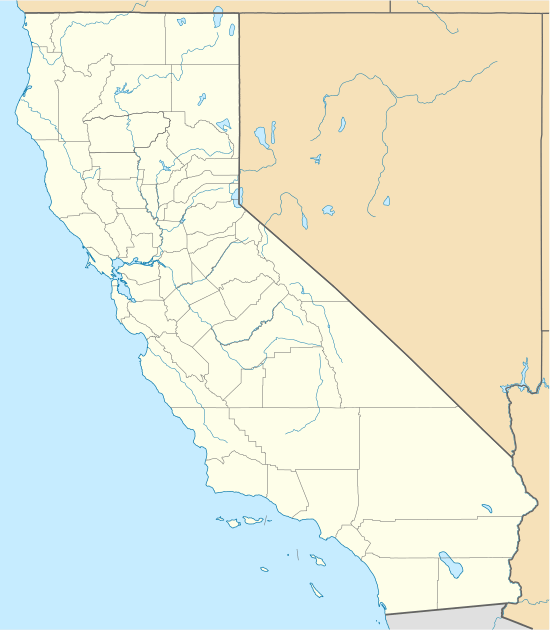Boron Air Force Station
Boron Air Force Station is a closed United States Air Force General Surveillance Radar station. It is located 6.8 miles (10.9 km) northeast of Boron, California. It was closed by the Air Force in 1975 and turned over to the Federal Aviation Administration (FAA). The radar site is still operated by the FAA as part of the Joint Surveillance System (JSS).
Boron Air Force Station | |
|---|---|
| Part of Air Defense Command (ADC) | |
 Boron AFS Location of Boron AFS, California | |
| Coordinates | 35°04′54.1″N 117°34′58.4″W[1] |
| Type | Air Force Station |
| Code | ADC ID: P-59, NORAD ID: Z-59 |
| Site information | |
| Controlled by | |
| Site history | |
| Built | 1952 |
| In use | 1952–1975 |
| Garrison information | |
| Garrison | 750th Aircraft Control and Warning Squadron |
History
Boron Air Force Station was one of twenty-eight stations built as part of the second segment of the Air Defense Command permanent radar network. Prompted by the start of the Korean War, on July 11, 1950, the Secretary of the Air Force asked the Secretary of Defense for approval to expedite construction of the permanent network. Receiving the Defense Secretary's approval on July 21, the Air Force directed the Corps of Engineers to proceed with construction.
The 750th Aircraft Control and Warning Squadron was assigned to Atolia, California on 28 January 1952. It assumed coverage responsibilities formerly held by the temporary "Lashup" site at Edwards AFB site (L-40), and was operating two AN/FPS-10 radars at this new site, and initially the station functioned as a Ground-Control Intercept (GCI) and warning station. As a GCI station, the squadron's role was to guide interceptor aircraft toward unidentified intruders picked up on the unit's radar scopes. Atolia AFS was renamed "Boron Air Force Station" on 1 December 1953.
The AN/FPS-10 search radar at Boron remained until 1959. In 1958 an AN/FPS-6 replaced the AN/FPS-10 height-finder radar. A second height-finder radar (AN/FPS-6A) was installed in 1959.
During 1961 Boron AFS joined the Semi Automatic Ground Environment (SAGE) system, feeding data to DC-17 at Norton AFB, California. After joining, the squadron was redesignated as the 750th Radar Squadron (SAGE) on 1 May 1961. The radar squadron provided information 24/7 the SAGE Direction Center where it was analyzed to determine range, direction altitude speed and whether or not aircraft were friendly or hostile.
In addition to the main site, a Ground Air Transmit Receive (GATR) site was located 3.5 miles north of the main site, at a heading of 335 degrees, in order to gain some distance from the high-powered RF energy from the search radar systems. The GATR sites were used to communicate audibly to intercept aircraft in order to vector them to airborne targets. AN/GRT-3 [2] systems were the transmitters used, along with AN/GRR-7 [3] receivers. Backup Transceivers, AN/GRC-27 [4] systems were used to cover frequencies that were lost due to outages of the main transmitters and receivers. In addition to these, an AN/GKA-5 Time-division Data-link (TDDL) system [5][6] was used to digitally provide the vectoring data to the F-106 Delta Dart intercept aircraft.
In addition to the defense mission, Boron AFS became a joint-use facility with the Federal Aviation Administration (FAA) for use in tracking aircraft in the Los Angeles sector. By this time the AN/FPS-10 had been replaced by an AN/FPS-20 search radar. However, this radar was soon replaced by an AN/FPS-35 FD radar. By 1963 this radar operated with AN/FPS-26A and AN/FPS-90 height-finder radars. Boron AFS was re-designated as NORAD ID Z-59 on 31 July 1963.
In 1968 the AN/FPS-90 was inactivated. In 1969 the AN/FPS-35 was removed, and was replaced by an AN/FPS-67 on the same tower (and with a radome); it became operational in 1970.
In addition to the main facility, Boron operated several AN/FPS-14 Gap Filler sites:
- Shafter, CA (P-59A) 35°30′07″N 119°11′50″W
- Joshua Tree, CA (P-76F), (P-59C) 34°09′17″N 116°12′08″W
Over the years, the equipment at the station was upgraded or modified to improve the efficiency and accuracy of the information gathered by the radars. The 750th Radar Squadron was inactivated on 30 June 1975. The FAA retained the AN/FPS-67, and continue to operate it today and is now data-tied into the Joint Surveillance System (JSS).
Boron AFS was later converted into a Federal Prison in 1979, for minimum security male inmates, which was closed in 2000. The prison site and housing area have been completely demolished. The U.S. Department of Justice is currently investigating trespass activity at FPC Boron. All identified instances of trespass are logged, and trespassers may be subject to federal and state prosecution including imprisonment and/or fines.[7] It may eventually be sold as surplus property through the GSA.
Air Force units and assignments

Units
- Constituted as the 750th Aircraft Control and Warning Squadron
- Activated at Edwards AFB, California on 8 October 1950[8]
- Moved to Atolia, California on 28 January 1952[9]
- Site redesignated Boron Air Force Station, 1 December 1953
- Redesignated 750th Radar Squadron (SAGE) on 1 May 1961
- Redesignated 750th Radar Squadron on 1 February 1974
- Inactivated on 30 June 1975
Assignments
- 544th Aircraft Control and Warning Group, 1 January 1952
- 27th Air Division, 6 February 1952
- Los Angeles Air Defense Sector, 1 October 1959
- 27th Air Division, 1 April 1966
- 26th Air Division, 19 November 1969 – 30 June 1975
References
![]()
- U.S. Geological Survey Geographic Names Information System: Boron Air Force Station (historical)
- http://www.radiomuseum.org/r/military_radio_transmitting_set_an.html
- http://radionerds.com/images/b/bf/TO-31R2-2GRR7-2.pdf
- http://radionerds.com/index.php/AN~GRC-27
- http://www.radomes.org/museum/equip/radarequip.php?link=gka-5.html
- http://www.f-106deltadart.com/sage_system.htm
- http://www.bop.gov/locations/fpc_boron.jsp
- Mueller, Robert, Air Force Bases, Vol. I, p. 127
- Ibid.
- Cornett, Lloyd H. and Johnson, Mildred W., A Handbook of Aerospace Defense Organization 1946 – 1980, Office of History, Aerospace Defense Center, Peterson AFB, CO (1980).
- Mueller, Robert, Air Force Bases, Vol. I, Active Air Force Bases Within the United States of America on 17 September 1982, Office of Air Force History, Washington DC (1989) ISBN 0-912799-53-6.
- Winkler, David F. & Webster, Julie L., Searching the Skies, The Legacy of the United States Cold War Defense Radar Program, US Army Construction Engineering Research Laboratories, Champaign, IL (1997).
- Information for Boron AFS, CA
